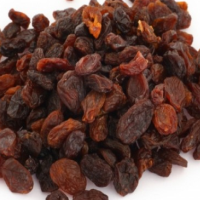U.S. Supreme Court Ends Depression-Era Raisin Price Support System

A New Deal-era system that stabilizes the market for certain commodities, especially California raisins, was found unconstitutional by the U.S. Supreme Court after a Fresno farmer broke with other growers and accused the government of illegally taking his property.
The system of government reserves was established in the 1930s to stabilize a broken market and provide price supports. It used to cover walnuts, almonds and other products, but they were either eliminated or greatly scaled back after World War II. California grows more raisins than any state and most years the U.S. is the world’s top grower.
Raisin farmers are required to pool a certain percentage of their crop with other growers. The government sells those reserves for export or uses them in food programs, while returning the proceeds to growers with certain guarantees built in.
It has seemingly worked for decades and most growers reportedly like the system. Marvin D. and Laura Horne do not and refused to participate. Marvin Horne told the Wall Street Journal that big growers like it because the federal government is helping them make inroads internationally. Sun Maid Growers of California cooperative produces 30% of the state’s raisins.
They changed their business model to include packaging raisins for other farmers and said they were now “producers,” not “handlers,” and were not covered by the law.
The U.S. Department of Agriculture’s Raisin Administrative Committee said they violated the regulation and fined them $685,000 in 2004. The government also demanded 1.2 million pounds of missing raisins. The Hornes said the government violated the Fifth Amendment by “taking” their property without just compensation and sued.
The U.S. Ninth Circuit Court of Appeals disagreed with the Hornes, not once, but twice. First, it wouldn’t let the Hornes make the Fifth Amendment argument. And when the Supreme Court said it was a valid argument to make, the appellate court rejected it on its merits. The Supremes reversed that decision.
Chief Justice John Roberts, writing for the court, reached back to the Magna Carta and the American Revolution in categorically denying the government’s right to set up a raisin reserve program. He dismissed the Ninth Circuit’s argument that precedent dealt with real property and this case was about personal property. Property was property and government needed better excuses to take it.
Roberts did not care for a precedent offered by the government involving oysters (“Raisins are not like oysters” because they aren’t harvested from public property) and ridiculed the “notion that general regulatory activity such as enforcement of quality standards can constitute just compensation for a specific physical taking.”
He also acknowledged that government can achieve many of the same policy goals by simply limiting farm production and using other regulations, but the opportunity to talk smack about violators of the Takings Clause was too powerful.
Justice Stephen Breyer partially concurred and partially dissented, and was joined by Justices Ruth Bader Ginsburg and Elena Kagan. Justice Sonia Sotomayor offered a “respectful dissent,” but she seemed gobsmacked.
Sotomayor said past court cases gave the Hornes four legal arguments to establish a taking under the Fifth Amendment. They chose one―a “per se” taking which “requires a property owner to suffer a ‘permanent physical occupation’ of his or her property.” The precedent is Loretto v. Teleprompter Manhattan CATV Corp.
But Loretto is clear, Sotomayor said, “Where some property right is retained by the owner, no per se taking under Loretto has occurred.” The Hornes retained some of their “taken” property because they got a fair chunk of change from the government for their “reserve” contribution.
Roberts said she was wrong.
–Ken Broder
To Learn More:
Supreme Court Sides with Raisin Farmers in Property Rights Case (by Adam Liptak, New York Times)
Supreme Court Strikes Down New Deal-Era Raisin Price-Support Program (by Jess Bravin, Wall Street Journal)
Supremes Hand Victory to CA Raisin Growers (by Barbara Leonard, Courthouse News Service)
Supreme Court Sides with Fresno Farmer in Raisin Dispute (by David G. Savage, Los Angeles Times)
Fight over Government “Raisin Reserve” Spreads from Courts to Congress (by Matt Bewig, AllGov)
Horne et al v. Department of Agriculture (U.S. Supreme Court) (pdf)
- Top Stories
- Controversies
- Where is the Money Going?
- California and the Nation
- Appointments and Resignations
- Unusual News
- Latest News
- California Forbids U.S. Immigration Agents from Pretending to be Police
- California Lawmakers Urged to Strip “Self-Dealing” Tax Board of Its Duties
- Big Oil’s Grip on California
- Santa Cruz Police See Homeland Security Betrayal in Use of Gang Roundup as Cover for Immigration Raid
- Oil Companies Face Deadline to Stop Polluting California Groundwater





